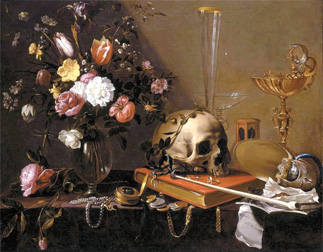Depictions of death over the ages

“Still-Life with a Bouquet and a Skull” (1642), by Adriaen van Utrecht (1599-1652). Oil on canvas, 67 x 86 cm, Private collection
Let’s take a look at “Love,” one of the award-winning pieces from a contest held by Korea’s Health Ministry earlier this year to select warning images for cigarette packages. The piece features a pale hand with a finger burning away just like a cigarette, with another, much smaller hand holding the finger. The smoke from the burning finger takes the vague form of a white skull.

“Love” (2009), by Hong Chan-gil. Provided by MBC Production
The image of the burning finger in this picture is terrible. But it is not as strong as some anti-smoking advertisements in other countries, in which arms and legs - not just fingers - are burning away. There is even an ad in India in which smokers’ whole bodies are already burned away except for their arms, which are still holding cigarettes! There are numerous anti-smoking ads like these worldwide that use shocking images to get their point across.
I don’t doubt that the producers of such ad campaigns have the noble intention of promoting health for all mankind by getting people to hate smoking. But I suspect that the producers, at the same time, might secretly enjoy giving people shudders, just like Hieronymus Bosch and other Northern Renaissance artists who painted hair-raisingly hellish scenes.
The infernal paintings by these artists have a religious bent, looking to encourage people to perform good deeds by showing how terrible they’ll have it if they commit sins. Still, I think the creatively grotesque and bizarre details highlight the artists’ sadistic pleasures as well.
Anti-smoking ads today, which repeatedly remind us of death, are also related to another tradition of Western art - the theme of “memento mori,” a Latin phrase meaning “remember you must die.” Of course, death as it’s portrayed in anti-smoking ads comes early due to smoking, whereas death in memento mori paintings is portrayed as something that mortals cannot avoid. Still, both kinds of pictures remind us of death through the use of skulls. In particular, anti-smoking ads have much in common with vanitas still-life paintings, a type of memento mori artwork that was popular in the Netherlands and Flanders in the 17th century.
For example, a vanitas painting by Flemish painter Adriaen van Utrecht (1599-1652) depicts a skull with a pipe on a table. Wow, so this is the 17th-century version of an anti-smoking campaign? Not really. The pipe in this painting is a symbol of sensuous and passing pleasures, though the skull is the symbol of death, just like it is in anti-smoking ads. The luxurious items on the table - which include a pearl necklace, gold coins and an elaborately made metal goblet - represent wealth and prosperity, while the book under the skull symbolizes culture and academic achievements.
But under the pipe there is piece of paper that contains a Latin phrase from the Book of Ecclesiastes: “Vanitas vanitatum omnia vanitas,” which translates to “Vanity of vanities, all is vanity.” In other words, the painting says that all of these luxurious items are vain in the face of inevitable death. After all, what are you going to do with a pearl necklace when you die?
Bolstering that message, the pocket watch in the front part of the painting and the hourglass hidden in the back remind us that we are always getting closer to death. And the withering flowers in the beautiful bouquet on the left side of the painting emphasize that youth will not last. The overarching theme is that mortals shouldn’t cling to things in this life.
The message of memento mori had already appeared in medieval paintings with the “Dance of Death” theme, which I introduced before in this column. And, as still-lifes developed into independent paintings and stoic Protestantism spread in 17th-century Netherlands, the message of memento mori came into still-life paintings, giving birth to the genre of vanitas.
Some still-life paintings of this era, even those without a skull or a burned-down candle, deliver the message of vanitas. How? They feature withering flowers juxtaposed with fresh flowers to show the passing of life. Table still-life paintings also included vanitas messages. “Still Life with Herring,” by Pieter Claesz (1597-1661), emphasizes mortality through its depiction of a cut-up fish showing signs of decay. The tradition of vanitas paintings is alive in modern and contemporary art. One example is the installation artwork titled “Majestic Splendor,” by Korean artist Lee Bul (1964-present), which was exhibited at the Museum of Modern Art in New York City in 1997. The artwork - an actual dead fish adorned with beads and other items - was left to decay, summoning the message of vanitas. Unfortunately, the work was removed a week later, due to complaints about its disgusting smell.
Still, it is remembered in the art world, as it highlighted the irony of miserable decay despite splendid decoration - just what the earlier vanitas works showed.
Today, we can see vanitas in modern art galleries in Korea and other countries. But you don’t even have to trek that far, as vanitas art is alive and well on anti-smoking posters on the streets.
by Moon So-young [symoon@joongang.co.kr]










with the Korea JoongAng Daily
To write comments, please log in to one of the accounts.
Standards Board Policy (0/250자)